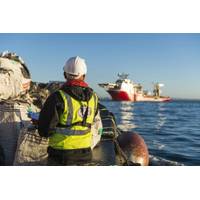French Wind Turbines Avoid Radar Interference
Denmark's Vestas to build 1st stealth turbines in France; new blades use surface coatings inspired by warplanes. Vestas studying export potential of the new technology; growing tensions between French army and wind industry.
France is building the world's first wind farm with turbine blades designed to minimise interference with radar systems, using technology partially inspired by stealth warplanes.
EDF Energies Nouvelles, the renewables unit of state-controlled utility EDF, aims to install the new Vestas-built turbines next spring in the "Ensemble Eolien Catalan" wind farm near Perpignan and start operating them over the course of 2015.
"It is a world premiere for this new technology," an EDF EN spokeswoman said.
The turbines will account for the entire 96 megawatts of capacity, which she said would make it the biggest wind farm in France.
Around the world, dozens of wind farm projects have been blocked or delayed because of potential radar interference, which can mask the signals of other objects. Turbine makers have put years of research into radar signature reduction, most of which is still in the experimental stage.
Denmark's Vestas, the world's largest maker of land-based wind turbines, said the new blades would have a smaller radar signature.
"We have used surface treatment technologies, including those derived from military applications," said Nicolas Wolff, head of the Danish firm's French unit.
Radar-evading jets such as the Lockheed Martin (LMT) F-117 Nighthawk use a combination of shapes, angled surfaces and radar-absorbing coatings to mask their "radar cross section", a measure of the extent to which they are detectable by radar.
Wolff said that Vestas needed one or two more years of research to study the potential for exporting the technology and that Britain and the United States were possible markets.
TENSIONS WITH ARMY
EDF EN had tested the new technology on two turbines in a wind park in Auvergne, in central France.
In France, close to 6,000 MW of wind farm projects have been blocked because of fear of interference with military or weather radar, French Windfarm Federation (FEE) said.
"There is a conflict here; there are two kinds of users for the same space. For us, it is a real problem," said FEE director Sonia Lioret.
The French air force has traditionally had a strong presence in the skies at home. Military interventions in Libya, Mali and Central African Republic in recent years have increased training needs at a time when France's wind farm investment is catching up with a renewable energy boom in Europe.
The French army must be consulted about any wind farms planned within 30 km of its radar stations, and is putting up more resistance to new projects, given that the newest turbines can be as tall as 150 metres.
The defence and energy ministries, asked for comment, did not respond. They are set to hold joint discussions over the issue later this year.
The defence ministry told parliament in a July statement that it needed to ensure "sufficient capacity" for its warplanes to fly at low altitudes, both for defence and training missions.
Writing by Geert De Clercq












